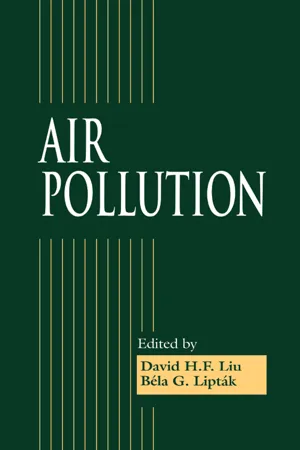![]()
1
Pollutants: Sources, Effects, and Dispersion Modeling
Larry W. Canter | David H.F. Liu | Roger K. Raufer | Curtis P. Wagner
1.1
SOURCES, EFFECTS, AND FATE OF POLLUTANTS
Sources of Air Pollution
Point, Area, and Line Sources
Gaseous and Particulate Emissions
Primary and Secondary Air Pollutants
Emission Factors
Emission Inventories
Nationwide Air Pollution Trends
Effects of Air Pollution
Economic Losses
Visible and Quantifiable Effects
Biodiversity
Deterioration of Exposed Materials
Health Effects
Atmospheric Effects
Rainfall Quality
Tropospheric Ozone—A Special Problem
Brief Synopsis of Fate of Air Pollutants
Effects of Wind Speed and Direction
Effects of Atmospheric Turbulence
Effects of Atmospheric Stability
Effects of Topography on Air Motion
Other Factors
1.2
VOCs AND HAPs EMISSION FROM CHEMICAL PLANTS
Emission Points
Process Point Sources
Process Fugitive Sources
Area Fugitive Sources
Classification of VOCs and HAPs
1.3
HAPs FROM SYNTHETIC ORGANIC CHEMICAL MANUFACTURING INDUSTRIES
Hazardous Organic NESHAP
Process Vents
Storage Vessels
Transfer Operations
Wastewater
Solid Processing
Toxic Pollutants
1.4
ATMOSPHERIC CHEMISTRY
Basic Chemical Processes
Catalytic Oxidation of SO2
Photochemical Reactions
Particulates
Long-Range Planning
1.5
MACRO AIR POLLUTION EFFECTS
Acid Rain Effects
Effects on Forests
Effects on Soil
Effects on Groundwater
Effects on Surface Water
Effects on Materials
Effects on Health
Losses in Stratospheric Ozone Layer
Global Warming
Ecological Impact
Impact on Water Resources
Impact on Agriculture
Impact on Air Quality
Impact on Human Health
1.6
METEOROLOGY
Wind
Scales of Air Motion
Wind Rose
Turbulence
Lapse Rates and Stability
Lapse Rates
Stability
Inversions
Precipitation
Topography
Land-Sea Breeze
Mountain-Valley Winds
Urban-Heat-Island Effect
1.7
METEOROLOGIC APPLICATIONS IN AIR POLLUTION CONTROL
Air Pollution Surveys
Selection of Plant Site
Allowable Emission Rates
Stack Design
1.8
ATMOSPHERIC DISPERSION MODELING
The Gaussian Model
Plume Characteristics
Dispersion Coefficients
Stability Classes
Wind Speed
Plume Rise and Stack Height Considerations
Plume Rise
Briggs Plume Rise
Downwash
Tall Stacks
Computer Programs for Dispersion Modeling
Guideline Models
Model Options
Screening and Refined Models
Simple and Complex Terrain
Urban and Rural Classification
Averaging Periods
Single and Multiple Sources
Type of Release
Additional Plume Influences
Meteorology
Other Models
Mobile and Line Source Modeling
CALINE3 Model
CAL3QHC Model
BLP Model
1.1
SOURCES, EFFECTS, AND FATE OF POLLUTANTS
Air pollution is defined as the presence in the outdoor atmosphere of one or more contaminants (pollutants) in quantities and duration that can injure human, plant, or animal life or property (materials) or which unreasonably interferes with the enjoyment of life or the conduct of business. Examples of traditional contaminants include sulfur dioxide, nitrogen oxides, carbon monoxide, hydrocarbons, volatile organic compounds (VOCs), hydrogen sulfide, particulate matter, smoke, and haze. This list of air pollutants can be subdivided into pollutants that are gases or particulates. Gases, such as sulfur dioxide and nitrogen oxides exhibit diffusion properties and are normally formless fluids that change to the liquid or solid state only by a combined effect of increased pressure and decreased temperature. Particulates represent any dispersed matter, solid or liquid, in which the individual aggregates are larger than single small molecules (about 0.0002 μm in diameter) but smaller than about 500 micrometers (μm). Of recent attention is particulate matter equal to or less than 10 μm in size, with this size range of concern relative to potential human health effects. (One μm is 10−4 cm).
Currently the focus is on air toxics (or hazardous air pollutants [HAPs]). Air toxics refer to compounds that are present in the atmosphere and exhibit potentially toxic effects not only to humans but also to the overall ecosystem. In the 1990 Clean Air Act Amendments (CAAAs), the air toxics category includes 189 specific chemicals. These chemicals represent typical compounds of concern in the industrial air environment adjusted from workplace standards and associated quality standards to outdoor atmospheric conditions.
The preceding definition includes the quantity or concentration of the contaminant in the atmosphere and its associated duration or time period of occurrence. This concept is important in that pollutants that are present at low concentrations for short time periods can be insignificant in terms of ambient air quality concerns.
Additional air pollutants or atmospheric effects that have become of concern include photochemical smog, acid rain, and global warming. Photochemical smog refers to the formation of oxidizing constituents such as ozone in the atmosphere as a result of the photo-induced reaction of hydrocarbons (or VOCs) and nitrogen oxides. This phenomenon was first recognized in Los Angeles, California, following World War II, and ozone has become a major air pollutant of concern throughout the United States.
Acid rain refers to atmospheric reactions that lead to precipitation which exhibits a pH value less than the normal pH of rainfall (the normal pH is approximately 5.7 when the carbon dioxide equilibrium is considered). Recently, researchers in central Europe, several Scandinavian countries, Canada, and the northeastern United States, have directed their attention to the potential environmental consequences of acid precipitation. Causative agents in acid rain formation are typically associated with sulfur dioxide emissions and nitrogen oxide emissions, along with gaseous hydrogen chloride. From a worldwide perspective, sulfur dioxide emissions are the dominant precursor of acid rain formation.
Another global issue is the influence of air pollution on atmospheric heat balances and associated absorption or reflection of incoming solar radiation. As a result of increasing levels of carbon dioxide and other carbon-containing compounds in the atmosphere, concern is growing t...
